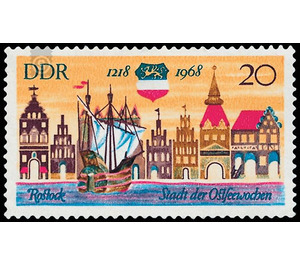750 years Rostock - Germany / German Democratic Republic 1968 - 20 Pfennig
Theme: Architecture
| Country | Germany / German Democratic Republic |
| Issue Date | 1968 |
| Face Value | 20.00 |
| Color | multi-colored |
| Perforation | K 14 |
| Printing Type | Photogravure |
| Stamp Type | Postage stamp |
| Item Type | Stamp |
| Chronological Issue Number | 1126 |
| Chronological Chapter | GER-DDR |
| SID | 812995 |
| In 21 Wishlists | |
Rostock - City of the Baltic Sea Weeks The Ministry of Posts and Telecommunications of the German Democratic Republic issues for Rostock, the city of the Baltic Sea weeks, two multicolored special postage stamps. In 1968, the 11th Baltic Week takes place. At the same time, the city is celebrating its 750th anniversary. Rostock - City of the Baltic Sea Weeks On the occasion of the 11th Baltic Sea Weeks and the 750th anniversary of the city of Rostock, two special postage stamps and a first day cover envelope are issued. The series is supplemented with a special cancellation. The two special postage stamps show distinctive buildings from the medieval and modern Rostock under the coat of arms with symbols of the most important economic sectors of the city, the sea and port economy. 20 Pfennig value The view shows highly stylized and arbitrarily strung together, but unmistakably derived from the historical template, views from the famous Vicke Schorler role, a building and cultural-historical document of the highest order. This "True Abcontrafactur of the highly-public and world-famous old sea and Hanseatic city of Rostock, Heubstadt in the country to Mecklenburg 1578-1586" is a 18,7 m long and 0,6 m high image roll glued together from 127 lawyer sheets. From 1578 to 1586, ie eight years long, the later senior clerk of the Krameramt in Rostock, Vicke Schorler (from today's term of a "lay artist") depicted with extreme meticulousness the 325 most important buildings of late medieval Rostock in a colored pen and ink drawing. The role is well preserved and is in the custody of the Rostock city archives. The buildings taken over in the stamp are stylized. On the right is undoubtedly the city balance, indicated by the wide entrance gates and a staircase, next to the newly built in 1576 Renaissance style stone gate, which we find on the second postage stamp on the left. This is followed by two town houses with the typical large entrance doors and the Gothic brick gables characteristic of the medieval Rostock style. Behind the cog, there are five turrets. This building is the former Holy Spirit (Hospital) Church on Hopfenmarkt, which was opened in 1818. Next to it is a community center and on the left another building. The Hansekogge floating from the rows of houses in the Warnow points to the main industry of the wealthy citizens of Rostock, the merchant shipping, and reminiscent of the nasic heyday of the city. This cog is modeled on an even earlier medieval cityscape, created by the Nuremberg letter painter, pattern tailor and printer Hans Wigel around 1560, around the same time as Vicke Schorler was born.


